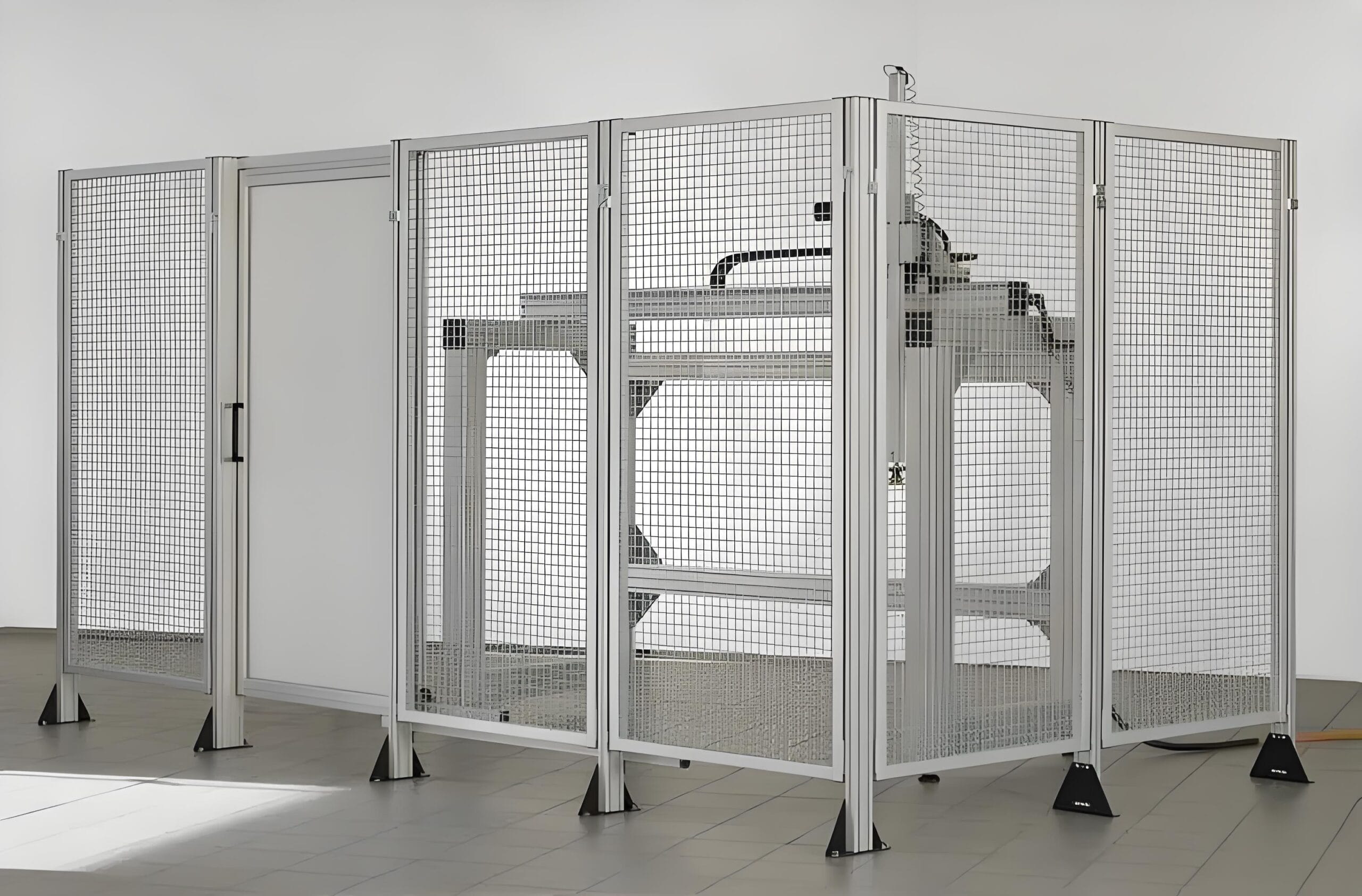Aluminum protection fences – the ultimate barrier system designed to bring both safety and functionality to your industrial workspace. This premium-grade machine guarding is crafted from robust industrial aluminum profiles, ensuring a sturdy and reliable shield against potential hazards.
Description
Clôtures de protection de profil en aluminium
En substance, Aluminum protection fences are including an array of elements such as horizontal and vertical bars, pillars, handrails, multiple horizontal bar configurations, and bases. Delving into details, the primary structure is typically including 4040 et 4080 profilés industriels en aluminium.
In contrast to traditional wrought iron fences that we predominantly weld, we assemble these aluminum profile fences with distinct fittings including bolts, internal connectors, corner attachments, anchor links, and expansion screws, offering both ease of disassembly and a visually appealing, secure design.

Machine de clôture de sécurité
Which Industrial Aluminum Profiles We Often Use to Make Protective Fences?
Premièrement, the 2040 industrial aluminum profile has a sectional dimension of 20x40mm and a weight of 0.9kg per meter, making it compact and lightweight. It’s an excellent choice for creating small partition fences, offering a fine balance of durability and elegance for modest applications.
Secondly, we commonly use the 3030 industrial aluminum profile within the aluminum fencing arena. And often selected for constructing industrial safety barriers. With its well-suited cross-sectional size and lighter weight, it may seem slight in comparison to larger profiles. But is perfectly adequate for crafting workshop partitions and site protective fences.
Its balanced dimensions make it a preferred option amongst designers, usually incorporated as the main structure in fence construction.
Lastly, the 4040 et 4080 industrial aluminum profiles are robust choices, heavier and with larger cross-sectional sizes than the 3030 profile. Users with higher safety demands, such as those needing equipment protection covers or robot enclosures, typically opt for the 4040 profiles. These offer substantial load-bearing capabilities, an optimal cross-section, and a reasonable price point.
When height and heavier loads are involved, the protective covers and guards benefit from the stronger 4080 profile, which is engineered to support greater weights and maintain resilience off the ground.
What are the Advantages of Using Aluminum Profiles to Make Fences?
1. Achieve regional division;
En général, aluminum profile fences, we use to divide the workshop area around the production equipment, which can prevent operators from direct contact with the equipment and serve as a safety warning. Such division can improve the working environment and work efficiency;
2. Dust-proof and easy to clean:
There is a lot of dust in the workshop. Our aluminum profile fences can use acrylic and aluminum-plastic panels to isolate dust and equipment well, reduce the dust layer falling into the equipment, and the overall look is very beautiful and tidy; don’t worry about cleaning problems, I’ll tell you a trick, just use a scouring pad with rosin or alcohol to wipe it clean, it’s very simple and convenient;
3: Easy to connect and reusable;
The aluminum profile fence connection adopts the material bolt punching connection, the grid and acrylic use U-profile grooves, which are all conventional accessories of industrial aluminum profiles, and are very convenient to install and disassemble. Accessories, profiles, plates and grids can be reused.
 Protective barriers are typically including industrial aluminum profiles due to several key benefits:
Protective barriers are typically including industrial aluminum profiles due to several key benefits:
1. Exceptional hardness of industrial aluminum profiles: These profiles boast a high level of rigidity, able to endure stretching forces and significant impacts. This makes them superior in resilience when compared to conventional construction materials.
2. Enhanced corrosion resistance: Aluminum alloy profiles naturally develop a dense layer of aluminum oxide film. When subjected to treatments like anodizing, their defensive properties are greatly amplified, resulting in remarkable resistance to corrosion.
3. Refined and sleek industrial aluminum surfaces: The material’s inherent properties allow it to be finished with a variety of surface treatments, leading to a smooth and sophisticated appearance. Popular options include painting, powder coating, anodizing, and electrophoresis.
4. Impeccable safety features: Industrial aluminum profiles are designed without visible welding points, presenting a seamless surface. We combine all fittings with non-weld methods for assembly, contributing to the overall safety of the structure.
5. Practicality of aluminum protective railing: The anodized surface creates a long-lasting barrier, ensuring the railings have a consistently smooth and unblemished finish. This permanent layer is maintenance-free, never rusts, and is straightforward to clean.
What We Should Notice when installing aluminum protection fences?
1. Standard installation sequence. The installation sequence is from bottom to top. People must not assemble here and there, and there must be continuity.
2. Standard installation accuracy. We assemble industrial fences with profiles of different sizes, so the accuracy of profile size is very important. The profile cutting error must be less than ±0.5mm, so that we can complete the installation smoothly.
3. Standard installation tools. During the installation process, we should use special installation tools. Such as rubber hammers, hexagonal wrenches, etc., which can reduce the scratches on the profile surface and prevent the bolts and nuts from being screwed.
4. After the installation we complete, ensure that the surface of the fence is smooth and free of burrs. There should be no skew, deformation, shaking, etc.. at the end of the installation.
5. The switch doors or passages left by the fence can be open. And used normally during installation, and there should be no obstacles. We should also install the logo on the fence during the installation process, and no omissions should occur.






